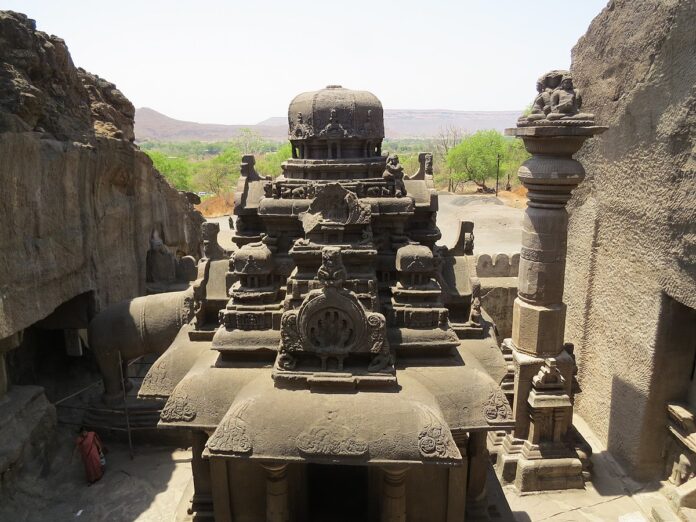The Monolithic Marvel of India: In the heart of India’s Maharashtra state lies a monumental wonder carved not with bricks and mortar, but from a single gigantic rock. The Kailasa Temple, nestled within the famed Ellora Caves of Aurangabad district, stands as an awe-inspiring example of ancient Indian artistry, devotion, and engineering brilliance. Unlike any other architectural structure in the world, this temple is not built — it is revealed, chiseled directly from a mountain to echo the celestial abode of Lord Shiva, the sacred Mount Kailash.
📍 Location and Historical Background
Kailasa Temple, also known as Cave 16 of the Ellora Caves, was commissioned in the 8th century CE by Rashtrakuta king Krishna I. The temple, dedicated to Lord Shiva, was envisioned as a physical manifestation of Mount Kailash on Earth — the mythical abode of Shiva according to Hindu scriptures.
The Rashtrakuta dynasty, known for its patronage of art, architecture, and religion, invested heavily in such grand architectural projects. The Kailasa Temple stands as their crowning achievement and an enduring symbol of their legacy.
🛕 Architectural Brilliance Beyond Imagination
The most astonishing aspect of the Kailasa Temple is that it was carved from a single monolithic rock. Using only hammers, chisels, and perhaps rudimentary iron tools, ancient craftsmen began sculpting from the top of the rock downward — a reverse engineering marvel that defies modern logic. This top-down technique ensured that no structural collapse occurred during the excavation and carving.
Estimates suggest that around 200,000 tons of rock were removed to create this structure. This volume and the precision required in sculpting every detail — from ceilings to statues — make the temple one of the largest monolithic structures in the world.
🎨 Divine Artistry in Stone
Walking through the premises of the Kailasa Temple is like stepping into a stone-etched storybook of Indian mythology. Every wall, pillar, and ceiling is intricately carved with scenes from the Ramayana, Mahabharata, and various Puranas. Massive elephants carved into the base appear to support the temple, adding both aesthetic appeal and symbolic grandeur.
At the temple’s heart lies a sacred Shiva Linga, surrounded by elaborately carved shrines, ornate columns, a Nandi Mandapa (pavilion of Shiva’s bull mount), and figures of deities including Vishnu, Lakshmi, Parvati, Ganesh, and Nataraja.
The attention to detail — from the folds in garments to the expressions on deities’ faces — showcases an unparalleled level of artistic excellence. No inch of the temple is left untouched; even the ceilings bear ornate floral and geometric patterns.
🕊️ A Symbol of Religious Harmony
The Kailasa Temple does not stand in isolation. It is part of the Ellora Cave complex, which features 34 caves in total — 17 Hindu, 12 Buddhist, and 5 Jain. These caves, constructed between the 6th and 10th centuries, display India’s religious pluralism and tolerance in its most artistic form.
That three major religious traditions flourished side by side, creating masterpieces within the same mountain, is a testament to a time when unity in diversity was not just a philosophy, but a way of life.
🌍 A Global Treasure
Recognized as a UNESCO World Heritage Site, the Ellora Caves, and particularly the Kailasa Temple, attract historians, archaeologists, architects, and tourists from across the globe. It serves as a case study in ancient engineering, often compared to the Pyramids of Egypt and Petra in Jordan.
The temple continues to inspire modern architects and engineers with its design, alignment, and earthquake-resilient structure — all achieved without the use of cement, steel, or modern surveying tools.
🔍 Mysteries and Legends
Despite being well-studied, many mysteries still surround the Kailasa Temple. How was such a large amount of rock removed in a time without dynamite or power tools? How were perfect proportions maintained without blueprints or scaffolding?
Legend holds that the temple was constructed in an incredibly short span of time. A popular folklore claims a queen prayed for the health of her ailing husband, and a promise was made that the temple would be completed before he recovered. Whether myth or fact, the speed, scale, and precision remain baffling even today.
🎒 A Journey Through Time – Tourist Experience
For visitors, a trip to Kailasa Temple is not just tourism, but pilgrimage through time. As one approaches the structure, the sheer scale becomes evident. Unlike freestanding temples, this one is cut into the rock — meaning you walk downward into its grandeur rather than ascending toward it.
Photographers revel in the play of light and shadow over ancient carvings, spiritual seekers meditate amidst the silence of stone, and children marvel at elephants that aren’t real, yet seem alive.
It is recommended to spend at least a full day exploring the Kailasa Temple and the surrounding Ellora Caves. Guides and local historians offer insightful narratives that enrich the visit manifold.
🛡️ Preservation and Modern Efforts
The Archaeological Survey of India (ASI) maintains the temple and surrounding caves, though challenges persist due to weathering, visitor footfall, and natural aging of stone. Conservation efforts are in place to ensure that this invaluable treasure remains intact for future generations.
There are growing calls to digitize and 3D-scan the entire temple complex, both for academic study and as a safeguard against future deterioration.
✨ Conclusion: More Than Just a Temple
The Kailasa Temple is not just a religious site — it is a monument of human capability, a canvas of mythological storytelling, and a symbol of cultural confluence. It exemplifies what a civilization can achieve when art, faith, engineering, and dedication come together in harmony.
Even after 1,200 years, it stands resilient and relevant, reminding us that some marvels are carved not just in stone, but in eternity.
Read More: Sikkim Golden Growth | A Beacon of Inclusive and Sustainable Development








[…] Read More: The Monolithic Marvel of India: Kailasa Temple – A Timeless Testament of Ancient Engineering […]